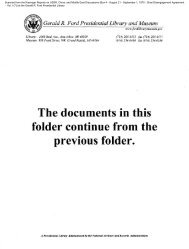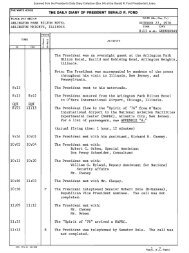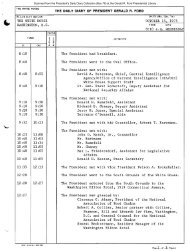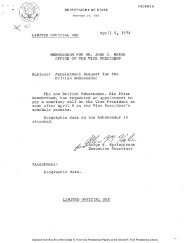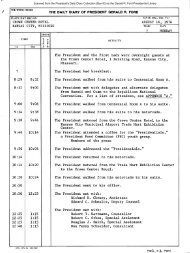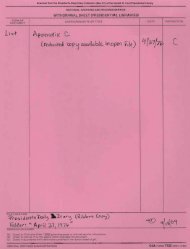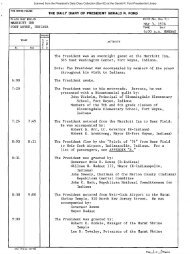October 31, 1975 - Gerald R. Ford Presidential Library and Museum
October 31, 1975 - Gerald R. Ford Presidential Library and Museum
October 31, 1975 - Gerald R. Ford Presidential Library and Museum
Create successful ePaper yourself
Turn your PDF publications into a flip-book with our unique Google optimized e-Paper software.
eserve est"imates. Such a detailed search <strong>and</strong> confirmation of data<br />
would tend to defeat the purpose of rapid machine processing for determining<br />
reserve estimates.<br />
Operators Survey Comparisons<br />
Reserve estimates of crude oil developed by decline curve analysis<br />
for 88 fields in Kansas, Oklahoma, <strong>and</strong> Texas were compared with the<br />
appropriate estimates from the Operators Survey for the same fields.<br />
These estimates were for fie1ds with decline curve reserves in excess of<br />
two million barrels in Kansas <strong>and</strong> Ok1ahoma <strong>and</strong> in excess of five million<br />
barre1s in Texas. Table 19 indicates the results of field by field<br />
comparison of reserves.<br />
Table 19--COMPARISON OF CRUDE OIL RESERVE ESTIMATES,<br />
DECLINE CURVE ANALYSIS VS. OPERATORS SURVEY<br />
Decline Curve Est. as Decline Curve<br />
a Percent of Survey<br />
Est.<br />
No. of<br />
·Fields Reserves<br />
(MMBb1s)<br />
Survey Reserves<br />
(MMBb1s)<br />
Under 50 7 56.9 139.0<br />
50 - 89 14 265.3 354.7<br />
90 - 109 7 112. 1 116.2<br />
110 - 149 17 281.3 222.4<br />
150 <strong>and</strong> over 43 749.8 363.0<br />
Total 88 1,465.4 1,195.3<br />
As Table 19 illustrates, the reserve estimates from decline curve<br />
analysis tended to be higher than those from the Operators Survey. The<br />
aggregate reserve totals for the 88 fields indicate that the decline<br />
curve figures were 20.8 percent higher than those of the Operators<br />
Survey while the aggregate reserve totals for the 47 Texas fields were<br />
only 9.5 percent higher. A small part of this can be explained by the<br />
fact that prior to 1971, Texas production was affected by Statewide<br />
allowables. Therefore, there were insufficient significant data available<br />
to project hyperbolic declines for any Texas fields,<strong>and</strong> only<br />
exponential declines were projected. The hyperbolic projections used for<br />
some fields in Kansas <strong>and</strong> Oklahoma tend to compute more optimistic<br />
reserve es'timates because of the fl atting of the curve.<br />
Major Field Studies Comparisons<br />
Only three of the fields studied by FEA that were amenable to decline<br />
curve analysis had comparable 1974 reserve estimates. The reserves from<br />
the decline curves were 19 percent higher than the corresponding reserves<br />
from the engineering studies.<br />
40



